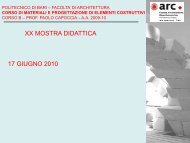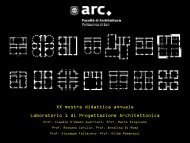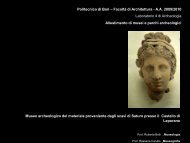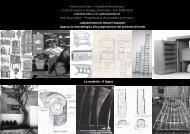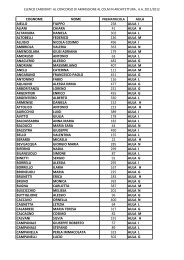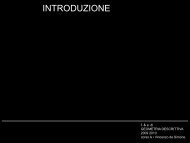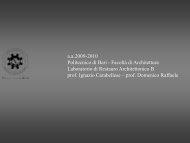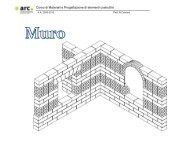Scarica il file pdf - Politecnico di Bari
Scarica il file pdf - Politecnico di Bari
Scarica il file pdf - Politecnico di Bari
Create successful ePaper yourself
Turn your PDF publications into a flip-book with our unique Google optimized e-Paper software.
capacità <strong>di</strong> valutazione storico-critica dellamateria, attraverso un colloquio.Teoria dell’architettura IITheory of architecture IIIcar 14-1,5 cfu2° anno / corso semestrale (I semestre)In<strong>di</strong>rizzo ‘generale’Area <strong>di</strong>dattica I:Progettazione architettonica e urbanaClau<strong>di</strong>o D’AmatoFinalità e contenuti <strong>di</strong>sciplinariObiettivo del corso è condurre l’allievo allariflessione sul nesso che intercorre franatura, qualità e modo del ragionamentod’architettura, e suo farsi prima progetto, epoi opera costruita.Il rapporto <strong>di</strong> necessità fra pensieroprogetto-costruzionesarà esplorato nelsuo concreto, storico inverarsi,ripercorrendo criticamente alcune tappefondamentali del pensiero architettonicooccidentale.La strategia <strong>di</strong>dattica consiste nell’<strong>il</strong>lustrareagli allievi <strong>il</strong> significato e la logica delleoperazioni che essi compiono nel primociclo della loro formazione; e rendergliconto della specificità della sintesiartistico-tecnico-scientifica dell’architettonella sua azione <strong>di</strong> trasformazione dellarealtà fisica, a confronto con quelle <strong>di</strong> altrefigure professionali ad esclusivo caratteretecnico che operano nel settoredell’architettura.Aims and contentsThe objective of the course is to lead thestudent to the reflect on the connectionbetween nature, quality and way ofdesigning architecture, and its becomingfirstly a project, and then bu<strong>il</strong>t work.The relationship of necessity betweenthought-project-construction w<strong>il</strong>l beexplored in its concrete, historical context,thinking back critically to somefundamental phases of westernarchitectural thought.The educational strategy consists of<strong>il</strong>lustrating the meaning and the logic of theoperations of the first educational cycle;and the specificity of the artistic-technicalscientificsynthesis of the architect in hisaction of transformation of the physicalworld, in comparison with those of otherprofessional figures with an exclusivetechnical character that operate in the fieldof the architecture.Articolazione delle attività <strong>di</strong>datticheIl nesso pensiero-progetto-costruzione saràindagato alla scala della città (in tre gruppi<strong>di</strong> lezioni):a) Teorie dello spazio architettonico eurbano nella Grecia classica enell’ellenismo, in Roma imperiale, aCostantinopoli:• La città organica del mondo antico,• Teorie dello spazio in Grecia e a Roma,• Lo spazio dell’antichità da Roma aBisanzio.b) Teorie dello spazio nel me<strong>di</strong>oevo e inepoca moderna:• Lo spazio romanico e gotico,• Lo spazio prospettico delrinascimento,• Lo spazio infinito barocco.c) Teorie dello spazio in epoca moderna econtemporanea:• La cattura dell’infinito,• Crisi della città organica del XVIIIsecolo e nascita della città moderna,• Teorie dello spazio urbano per la cittàcontemporanea.Per ciascun ciclo <strong>di</strong> tre lezioni sono previsteesercitazioni in aula. Queste prove, sesostenute con esito positivo, sostituisconol’esame finale (Teoria I + Teoria II). Coloroche in esse otterranno una valutazioneme<strong>di</strong>a negativa, sosterranno l’esame negliappelli previsti dal calendario accademico.Articulation of educational activitiesa) Theories of architectural and urbanspace in classical Greece and inHellenism, in Imperial Rome, inConstantinople:• The organic city of the ancient world,• Theories of space in Greece andRome,• The sense of space from Rome toByzantium.b) Theories of space in the Middle Agesand in the modern epoch:• The Romanesque and Gothic space,• The perspective space of theRenaissance,• The Baroque endless space.c) Theories of the space in modern andcontemporary epochs:• The capture of the infinite,• The crisis of the organic city of theXVIII century and the birth of themodern city,• Theories of urban space for thecontemporary city.For every lesson there are exercises on thee-learning platform, to be carried outbefore the following lesson.44.2.9 Progetti <strong>di</strong>dattici del I ciclo del CdLm in Architettura75




